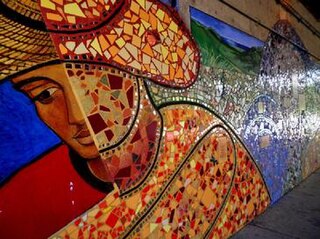
A mural is any piece of graphic artwork that is painted or applied directly to a wall, ceiling or other permanent substrate. Mural techniques include fresco, mosaic, graffiti and marouflage.

Bryan Douglas Caplan is an American economist and author. He is a professor of economics at George Mason University, a senior research fellow at the Mercatus Center, adjunct scholar at the Cato Institute, and a former contributor to the Freakonomics blog and EconLog. He currently publishes his own blog, Bet on It. Caplan is a self-described "economic libertarian". The bulk of Caplan's academic work is in behavioral economics and public economics, especially public choice theory.

Tiles are usually thin, square or rectangular coverings manufactured from hard-wearing material such as ceramic, stone, metal, baked clay, or even glass. They are generally fixed in place in an array to cover roofs, floors, walls, edges, or other objects such as tabletops. Alternatively, tile can sometimes refer to similar units made from lightweight materials such as perlite, wood, and mineral wool, typically used for wall and ceiling applications. In another sense, a tile is a construction tile or similar object, such as rectangular counters used in playing games. The word is derived from the French word tuile, which is, in turn, from the Latin word tegula, meaning a roof tile composed of fired clay.

The palmette is a motif in decorative art which, in its most characteristic expression, resembles the fan-shaped leaves of a palm tree. It has a far-reaching history, originating in ancient Egypt with a subsequent development through the art of most of Eurasia, often in forms that bear relatively little resemblance to the original. In ancient Greek and Roman uses it is also known as the anthemion. It is found in most artistic media, but especially as an architectural ornament, whether carved or painted, and painted on ceramics. It is very often a component of the design of a frieze or border. The complex evolution of the palmette was first traced by Alois Riegl in his Stilfragen of 1893. The half-palmette, bisected vertically, is also a very common motif, found in many mutated and vestigial forms, and especially important in the development of plant-based scroll ornament.

Hildreth Meière (1892–1961) was an American muralist active in the first half of the twentieth century who is especially known for her Art Deco designs. During her 40-year career she completed approximately 100 commissions. She designed murals for office buildings, churches, government centers, theaters, restaurants, cocktail lounges, ocean liners, and world’s fair pavilions, and she worked in a wide variety of mediums, including paint, ceramic tile, glass and marble mosaic, terracotta, wood, metal, and stained glass. Among her extensive body of work are the iconographic interiors at the Nebraska State Capitol in Lincoln, the dynamic roundels of Dance, Drama, and Song at Radio City Music Hall, the apse and narthex mosaics and stained-glass windows at St. Bartholomew's Episcopal Church (Manhattan), and the decoration of the Great Hall at the National Academy of Sciences in Washington, D.C.

Petworth is a neighborhood of Washington, D.C., located in Northwest D.C. While largely residential, Petworth is home to a notable commercial corridor of shops and restaurants, primarily along Georgia Avenue and Upshur Street, as well as a portion of 14th Street. The neighborhood is accessible via the Georgia Ave–Petworth station on the Green Line of the Washington Metro.
Ancient Maya art comprises the visual arts of the Maya civilization, an eastern and south-eastern Mesoamerican culture made up of a great number of small kingdoms in present-day Mexico, Guatemala, Belize and Honduras. Many regional artistic traditions existed side by side, usually coinciding with the changing boundaries of Maya polities. This civilization took shape in the course of the later Preclassic Period, when the first cities and monumental architecture started to develop and the hieroglyphic script came into being. Its greatest artistic flowering occurred during the seven centuries of the Classic Period.
Bob Flint, also known as Robert Flint, is an American ceramic artist. He arrived in Hawaii in 1960 for a summer of surfing and quickly realized that he wanted to stay. In 1961 he entered the University of Hawaii, earning his bachelor's and master's degrees in fine art, with a specialization in ceramics.

Frank Caplan was a youth worker, educator, folk toy collector, and pioneer in developing and manufacturing educational toys for children. He co-founded Creative Playthings in 1945 with his wife Theresa, and worked with artists, architects, and designers, such as Isamu Noguchi, Louis Kahn, Henry Moore, Robert Winston, and the Swiss toymaker, Antonio Vitali, to create innovative educational play objects and playground designs for children. By the 1950s, Creative Playthings had gained international recognition and expanded to become one of the most important manufacturers and suppliers of materials for early childhood education. In 1975, Frank Caplan founded The Princeton Center for Infancy and Early Childhood. He researched and co-authored a national bestselling series on early childhood development with Theresa Caplan, which included, The First Twelve Months of Life (1977), The Second Twelve Months of Life (1978), and The Early Childhood Years: The 2 to 6 Year Old (1983). Together they also co-authored The Power of Play (1973). He was one of the first male nursery school teachers in the U.S. and together with Theresa Caplan collected over 50,000 American and international folk toys, folk art, and contemporary playthings, which in 1984 the couple donated to The Children's Museum of Indianapolis for a permanent gallery on folk, fantasy, and play.

Gallifa is a municipality in the comarca of the Vallès Occidental in Catalonia, north-eastern Spain. It contains the Castle of Gallifa and was the location of the studio of ceramic artist Josep Llorens i Artigas and his son.
The Miró Wall is a ceramic tiled wall designed by Spanish artist Joan Miró for the Wilhelm Hack Museum in Ludwigshafen, Germany. The wall, which comprises 7,200 tiles, is 55 metres (180 ft) wide and 10 metres (33 ft) high.
Dorothy Annan was an English painter, potter and muralist who was born in Brazil to British parents and was educated in France and Germany. Her works were frequently shown at the Leicester Galleries in London and she had her first solo show there in 1945.

Chicago Public Art Group is a non profit cultural organization in Chicago that organizes and promotes creation of community public art. The Group was founded in 1971 and has been involved in the creation of hundreds of artworks in and around the city. CPAG supports the production of public murals, mosaics, sculptures and space designs in collaboration with community participants. CPAG also educates artists and the public about the history and possibilities of collaborative public art. Several of its works have been large bricolage mosaics in city underpasses.

Ann Agee is an American visual artist whose practice centers on ceramic figurines, objects and installations, hand-painted wallpaper drawings, and sprawling exhibitions that merge installation art, domestic environment and showroom. Her art celebrates everyday objects and experiences, decorative and utilitarian arts, and the dignity of work and craftsmanship, engaging issues involving gender, labor and fine art with a subversive, feminist stance. Agee's work fits within a multi-decade shift in American art in which ceramics and considerations of craft and domestic life rose from relegation to second-class status to recognition as "serious" art. She first received critical attention in the influential and divisive "Bad Girls" exhibition, curated by Marcia Tucker at the New Museum in 1994, where she installed a functional, handmade ceramic bathroom, rendered in the classic blue-and-white style of Delftware. Art in America critic Lilly Wei describes Agee's later work as "the mischievous, wonderfully misbegotten offspring of sculpture, painting, objet d'art, and kitschy souvenir."

The Wall of the Sun and Wall of the Moon are a pair of murals made of ceramics and designed by the Catalan artist Joan Miró for the UNESCO building in Paris. The works were carried out by the ceramicist Josep Llorens Artigas in 1955. Initially, the walls were installed on the Place de Fontenoy in Paris, but afterwards were enclosed in a building that was constructed in order to protect them from damage caused by acid rain.

The Sutton Heritage Mosaic is a large mural in the form of a mosaic situated in Sutton High Street in the town of Sutton in Greater London, England. One of the largest examples of wall art in Britain, it was commissioned by the London Borough of Sutton to celebrate the borough's heritage.

The Co-op Mosaic is a mural in Kingston upon Hull, England, designed by the artist Alan Boyson. Commissioned by the Hull and East Riding Co-operative Society for the exterior of the end of their new store, the mural is sited at the junction of Jameson Street and King Edward Street, now a mainly pedestrianised area created for the City of Culture 2017. The building was erected by 1963. Depicting three stylised trawlers, it commemorates Hull's fishing fleet.
Alan Boyson, RCA was an English muralist and sculptor, who worked chiefly in glass, ceramic and concrete.













